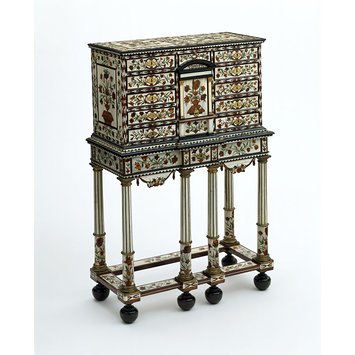In 1662, a year after becoming King in his own right, Louis installed many of Europe's finest craftsmen in the former tapestry workshops of the Gobelin brothers on the outskirts of Paris. Modelled on the Grand Ducal Workshops in Florence, these centres of excellence created mostly fitted furniture and fittings for the royal palaces and were also responsible for developing a unified design style that celebrated the glory of the King.
Royal Splendour
In 1682, Louis moved the French court into the Palace of Versailles. His favourite designer was Charles Le Brun, whose exuberant designs greatly impressed the King. Le Brun was responsible for many of the greatest rooms in Versailles, including the Hall of Mirrors.
Louis took a personal interest in the decoration and furnishing of his palace and much of the handmade furniture was embellished with visual references to him. The most common motifs were two interlaced 'L's', the fleur-de-lys, and the sunburst, Louis XIV's personal emblem.
The Edict Of Nantes
In 1685, Louis revoked the Edict of Nantes, thereby ending religious tolerance for Protestants. Many French designers and craftsmen, including Daniel Marot and Pierre Gole, fled abroad. This exodus helped spread the influence of French design to the rest of Europe and North America.
Ivory-Veneered Cabinet On Stand
This piece of fine antique furniture is attributed to the Dutch cabinet maker Pierre Gole (1620-1684) for the Cabinet Blanc (the White Room) in the Palace of Versailles.
Veneered in ivory, which acts as a background for floral marquetry in tortoiseshell and various woods, this cabinet is testament to the technical expertise of the maker.
The upper section consists of a series of small drawers on either side of a central recess. Within the recess, enclosed by doors, are three more drawers, all profusely inlaid with marquetry on ivory.
The cabinet stands on six fluted legs, also veneered in ivory, which have ball feet and are joined by flat stretchers. c.1662

Louis XIV Giltwood Canape
The shaped arms and supports of this gilded canape are wrapped with carved acanthus leaves and have strapwork decoration. The six scroll legs with matching decoration are joined by a double x-stretcher surmounted by urn finials.
The canape would originally have been upholstered in needlework or figured velvet. c.1700

No comments:
Post a Comment